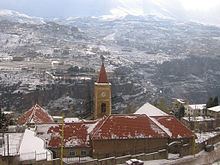Time zone EET (UTC+2) Local time Sunday 9:38 PM | Elevation 1,500 m (4,900 ft) Dialing code +961 Area code +961 | |
 | ||
Weather 4°C, Wind E at 6 km/h, 87% Humidity | ||
Why is arez bsharri the number one destination in lebanon this winter
Bsharri (Arabic: بْشَرِّيْ Bšarrī; also Romanized Becharre, Bcharre, Bsharre) is a town at an altitude of about 1,500 m (4,900 ft) in the Kadisha Valley in northern Lebanon. It is located in the Bsharri District of the North Governorate.
Contents
- Why is arez bsharri the number one destination in lebanon this winter
- Map of Bsharri Lebanon
- History
- Bsharri today
- Climate
- References
Map of Bsharri, Lebanon
Bsharri is the town of the only remaining (preserved) Original Cedars of Lebanon (Cedrus libani), and is the birthplace of the famous poet, painter and sculptor Khalil Gibran who now has a museum in the town to honor him.
History
The name Bsharri (بشرّي) can be found in the Phoenician language Bet Ishtar meaning "The House Of Ishtar", Ishtar being a goddess worshipped by the Phoenicians (and King Sulaymān) before Christianity was adopted in the area.
Bsharri was the site of a Phoenician settlement in ancient times. Maronite Christians fleeing persecution sought refuge in its mountainous terrain in the 7th Century AD. The Kadisha Valley, below the town, became the spiritual center of the Maronite Church. The town was known as Buissera by the Crusades.
In Lebanon, Bsharri natives are characterized as very courageous and tribal. They are known across the northern region for their hospitality and patriotism. They are especially known for their distinct accent when they speak Lebanese Arabic. Unlike other parts of Lebanon, Aramaic was spoken in Bsharri well into the 19th century. As a result, Bsharri natives developed an unmistakably strong accent which lasts to this day. There are seven main families in Bsharri: Chidiac, Fakhri, Geagea, Kairouz, Rahme, Succar, and Tawk. Other families are Arida, Choueiri, Shebaya and Boutros.
During the Lebanese civil war (1975–1990), Bsharri was a bastion of Christian resistance against the Palestinians and the Syrians. Many of its youth joined the Lebanese Phalanges at the start of the civil war. In 1986 Samir Geagea, a Bsharri native, became head of the Lebanese Forces (LF) militia (now a political party). Many LF militants were drawn from the town during the civil war. Bsharri natives are often referred to as defenders of the Maronite Christianity in Lebanon.
Unlike most of the other villages around, Bsharri is continuously inhabited during all the months of the year. That is why, even in the coldest days of winter, one can still find open shops to purchase his everyday needs.
Bsharri today
Today, the town is located in a highly touristic zone including many attractions such as the Khalil Gibran Museum, the Kadisha Valley, the Kadisha Grotto, the Cedars of God forest and several ski resorts.
Bsharri is home to a Lebanese Red Cross First Aid Center, also to "The Maronite Scouts" that started their activities in early 2000.
Currently, the District of Bsharri is represented in the Lebanese Parliament by two members, Mrs. Sethrida Tawk Geagea and Mr. Elie Kayrouz, both of them being from the Town of Bsharri and members of the Lebanese Forces political party.
Bsharri natives are also known for their strong Christian faith. Throughout the year, many religious festivities and commemorations take place in the town attracting thousands from neighbouring villages.
Climate
Bsharri has a continental Mediterranean climate (Csb/Dsb, according to the Köppen climate classification), with dry and mild summers and cold, snowy winters. Temperatures in the summer can go above 30 °C a few times per year. On the other hand, temperatures can plummet to -15 °C on some occasions during the winter. Heavy snowfall is observed every year and accumulations of over 2 meters are not unheard of.
